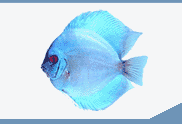

 |
||||||||||||
 |
||||||||||||
| Introduction to Freshwater Fish Parasites | ||||||||||||||||||||||||||
| Page 14 of 14 | Pages: 1 . 2 . 3 . 4 . 5 . 6 . 7 . 8 . 9 . 10 . 11 . 12 . 13 . 14 | |||||||||||||||||||||||||
LEECHES Leeches are occasionally seen in wild and pond-raised fish. They have a direct life cycle with immature and mature worms being parasitic on host's blood. Pathogenesis varies with number and size of worms and duration of feeding. Heavily infested fish often have chronic anemia. Fish may develop secondary bacterial and fungal infections at the attachment site. Leeches resemble trematodes but are much larger and have anterior and posterior suckers ( Figure 27 ). Dips in 3% saltwater are effective in controlling leeches. Ponds with heavy leech infestation require drainage, treatment with chlorinated lime, followed by several weeks of drying. This will destroy the adults and their cocoons containing eggs.  Figure 27: An illustration of a leech on the caudal fin.
Figure 27: An illustration of a leech on the caudal fin.
CONCLUSION Most fish health problems occur because of environmental problems: poor water quality, crowding, dietary deficiencies, or "stress". The best cure for any fish health problem is prevention. Good water quality management and proper fish husbandry techniques will eliminate most parasites described here. Information concerning basic fish culture, pond management, water quality, and economics is available in aquaculture extension circulars from your Cooperative Extension Service agent. ACKNOWLEDGMENTS The authors wish to especially thank Chris Tilghman and Peggy Reed for their artistic contributions to this circular, and Roy Yanong for the photo of Coccidia . Table 1: Chemical treatments for the control of external ciliates. "X" indicates that the chemical should not be used for this type of treatment.
-------------------------------------------------------- Footnotes 1. This document is Circular 716, one of a series of the Department of Fisheries and Aquatic Science, Florida Cooperative Extension Service, Institute of Food and Agricultural Sciences, University of Florida. First published March 1987 by Frederick J. Aldridge and Jerome V. Shireman; Reprinted April 1994; Revised December 1998. Please visit the EDIS Web site at http://edis.ifas.ufl.edu. 2. Ruth Ellen Klinger, biological scientist, Department of Large Animal Clinical Sciences (College of Veterinary Medicine) and Ruth Francis Floyd, associate professor, Department of Fisheries and Aquatic Sciences (Institute of Food and Agricultural Sciences), Department of Large Animal Clinical Sciences (College of Veterinary Medicine), Cooperative Extension Service, Institute of Food and Agricultural Sciences, University of Florida, Gainesville, 32611. -------------------------------------------------------- The Institute of Food and Agricultural Sciences is an equal opportunity/affirmative action employer authorized to provide research, educational information and other services only to individuals and institutions that function without regard to race color, sex, age, handicap, or national origin. For information on obtaining other extension publications, contact your county Cooperative Extension Service office. Florida Cooperative Extension Service / Institute of Food and Agricultural Sciences / University of Florida / Christine Taylor Waddill, Dean -------------------------------------------------------- Copyright Information This document is copyrighted by the University of Florida, Institute of Food and Agricultural Sciences (UF/IFAS) for the people of the State of Florida. UF/IFAS retains all rights under all conventions, but permits free reproduction by all agents and offices of the Cooperative Extension Service and the people of the State of Florida. Permission is granted to others to use these materials in part or in full for educational purposes, provided that full credit is given to the UF/IFAS, citing the publication, its source, and date of publication. 
SimplyDiscus.com gratefully thanks the Florida Cooperative Extension Service for permission to use this article. Please visit them at http://edis.ifas.ufl.edu/ |
 |
|||||||||||||||||||||||||
| About Us :: Message Board :: Chat | |||||
| Library :: Photo Gallery :: Links & Resources :: Breeders & Sponsors :: Merchandise | |||||
| Website designed by: EthanCote.com | � 2001-2004, SimplyDiscus.com. All Rights Reserved. | ||||